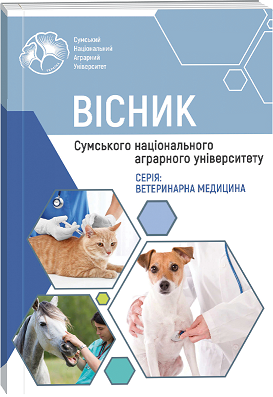EXPERIMENTAL STUDY OF THE EFFICACY OF APPLICATION OF CLAY FOR THE PREVENTION OF FISH AFLATOXICOSIS
Abstract
This article presents data on the use of a clay-based drug for the prevention of aflatoxicosis of fish. According to the results of research, it was found that in a clinical trial of clay proved its effectiveness for the prevention of aflatoxicosis of fish. The presented drug effectively neutralizes aflatoxin in feed and makes feed safe for consumption and fish a safe food. The use of clay is cost effective due to its low cost is safe for humans, animals and the environment. The aim of our research was to determine the effect of mycotoxins on fish. Conduct research on the safety of fish when consuming food with aflatoxin. Establish time ranges of maximum and minimum effects of aflatoxin on the body of fish Conduct pathological and anatomical studies of fish. To determine the features of aflatoxicosis in fish. Identify the lesions that fish suffer from aflatoxin. Carry out a veterinary assessment of fish meat for safety indicators when consuming fish feed with aflatoxin. Find out the effectiveness of using clay to prevent aflatoxicosis. The research was conducted on the basis of research of the Department of Veterinary Examination, Microbiology, Zoohygiene and Safety and Quality of Livestock Products of Sumy National Agrarian University. 1. During the experiment it was found that feed containing aflatoxin 0.4 mg / kg adversely affects the safety of fish. 2. Preservation of fish when fed food with aflatoxin for 30 days is 40%. 3. The liver has the greatest negative effect of aflatoxin in fish 4. Fish that consumed aflatoxin according to organoleptic and physicochemical parameters is classified as stale fish, pH - fish with aflatoxicosis is 7.0 ± 0.3. 5. Fish that consumed aflatoxin + clay according to organoleptic and physicochemical parameters is classified as fresh fish, pH - fish with aflatoxicosis + clay is 6.66 ± 0.3
References
2. Dvorska Yu. (2011). Mikotoksyny v kormakh: otsinka ryzyku [mycotoxins in feed risk assessment]. Zhurnal «Efektyvne ptakhivnytstvo» [Efficient poultry farming], (20), 9-11 [in Ukrainian]
3. Mari Eskola, Gregor Kos, Christopher T. Elliott, Jana Hajšlovád, Sultan Mayar, and Rudolf Krska (2020). Worldwide contamination of food-crops with mycotoxins: Validity of the widely cited ‘FAO estimate’ of 25%. Critical Reviews in Food Science and Nutrition, 60, 16, 2773-2789. https://doi.org/10.1080/10408398.2019.1658570
4. Fotina T. I., Berezovskyi A. V., Petrov R. V. (2013).Veterynarno-sanitarna ekspertyza ryby, morskykh ssavtsiv ta bezkhrebetnykh tvaryn [Veterinary Sanitary Examination of Marine Mammals and Invertebrates], 120 p. [in Ukrainian]
5. Iatsenko I.V., Bohatko N.M., Bulhakova N.V. (2017). Hihiiena i ekspertyza kharchovykh hidrobiontiv ta produktiv yikh pererobky. Chastyna 1. Hihiiena i ekspertyza rybopromyslovoi produktsii:[ Hygiene and Examination of Food Aquatic Organisms and Products of their Processing. Part 1. Hygiene and Examination of Fish Products] , 680 [in Ukrainian]
6. Khomenko V. I. (1998). Praktykum z veterynarno-sanitarnoi ekspertyzy z osnovamy tekhnolohii ta standartyzatsii produktiv tvarynnytstva ta roslynnytstva [Workshop on veterinary and sanitary examination with the basics of technology and standardization of production and crop production],240 [in Ukrainian]
7. Kravchenko L.V., Galash V.T., Avren`eva L.T. Kranauskas A.E. (1989). On the sensitivity of carp, Cyprinus carpio, to mycotoxin T-2. J. Ichthyol. , 29 (7), 156 – 160.
8. Kutsan O., Shevtsova H., Yaroshenko M. (2009). Hrybkove urazhennia zernovykh ta kombikormiv [Fungal lesions of cereals and feed.]. Tvarynnytstvo Ukrainy [Livestock of Ukraine]. (3), 24–27.
9. Lovell R.T. (1992). Mycotoxins: Hazardous to farmed fish. Feed International, 3, 24 – 28.
10. Manning B.B., Li M.H., Robinson E.H., Gaunt P.S., Camus A.C. and Rottinghaus G.E.. (2003). Response of channel catfish to diets containing T-2 toxin. J. Aquatic Animal Health, 15, 229-238.
12. Mykytiuk P. V. (1994). Laboratornyi praktykum z biolohii, patolohii ta vetsanekspertyzy prisnovodnykh ryb [Laboratory workshop on biology, pathology and veterinary examination of freshwater fish.], 120p. [in Ukrainian]
13. Mizhnarodnyi standart. Zerno furazhne, produkty yoho pererobky, kombikormy. Metod vyznachennia toksychnosti [ International standard. Fodder grain, products of its processing, compound feeds. Toxicity determination method] DSTU 3570-97 (HOST 13496.7-97). Zatverdzhenyi 28.02.98. Uvedenyi v diiu 01.07.99 [in Ukrainian]
14. Prasad B.N., Sinha B.K., A.K. Sinha. (1987). Aflatoxigenic fungi isolated from fish and its public health importance. Indian J. Comp. Microbiol. Immunol. Infect. Dis., 8(3), 135 – 136.
15. Zvit Derzhahenstva rybnoho hospodarstva za 2018[Report of the State Fisheries for 2018]. URL: https://darg.gov.ua/_publichnij_zvit_derzhavnogo_0_0_0_8359_1.html

 ISSN
ISSN  ISSN
ISSN 


